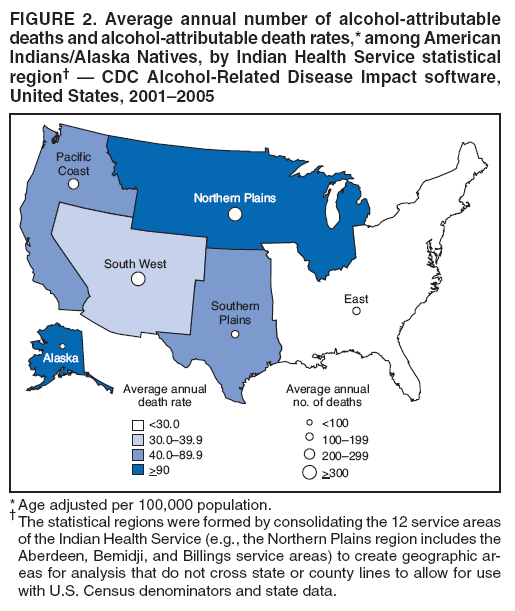 Excessive alcohol consumption is a leading cause of preventable death among American Indians and Alaska Natives, federal health officials reported last week.
Based on data from 2001-2005, the Indian Health Service
and the Centers for Disease Control and Prevention found that 11.7 percent of deaths among Native Americans were alcohol-related. This was twice the rate of the general population.
Native men made up the bulk of alcohol-related deaths, the data showed. They accounted for 65.9 percent of deaths among Native Americans below the age of 50.
Going by region, alcohol-related death were highest in the Northern Plains and Alaska. The average annul
death rates in these two regions topped 90 per 100,000, the data showed.
The average annual death rates in the Pacific Coast and the Southern Plains, a region that covers Oklahoma
and Texas, were the next highest, the report said. They were followed by the Southwest and finally the East,
a region that includes Maine, New York and Florida.
"This is the first national report" of alcohol-related deaths among American Indians and Alaska Natives, the researchers said in an editorial note, and "the results demonstrate that excessive alcohol consumption is a leading cause of preventable death and years of lost life in this population."
According to the data, a total of 5,553 alcohol-related deaths were seen among Native American from 2001-2005. The deaths were divided into two categories: acute and chronic.
Acute covers cases such as motor vehicle accidents, homicide and suicide. Chronic covers cases such as liver disease, cirrhosis and stroke.
During 2001-2005, an average of 1,514 alcohol-related deaths occurred among American Indians and Alaska Natives, the report said. The deaths were equally divided among acute and chronic cases.
Among acute cases, motor-vehicle traffic crashes accounted for 27.5 percent of deaths. Among chronic cases, liver disease accounted for 25.2 percent of deaths.
Reducing the number of alcohol-related deaths requires cooperation and coordination among tribes, local, state
and federal officials, both on and off the reservation, the researchers said in an editorial note. "Bans on the sale and possession of alcoholic beverages on certain Indian reservations have been shown to reduce consumption and related harms, although the efficacy of such policies is influenced by access to alcohol in surrounding communities," the note stated.
Alcohol is banned on many reservations, such as the Navajo Nation, the largest in the country. Federal authorities in Arizona recently broke up the largest bootlegging ring there in tribal history and the tribe is currently weighing alcohol sales at its first casino.
The Pine Ridge Reservation in South Dakota, one of the largest in the country, is also dry but members of the Oglala Sioux Tribe are able to drive a
few miles to the town of Whiteclay, Nebraska, to purchase beer. Tribal activists blame alcohol on a wide range of social problems and unsolved deaths.
The IHS/CDC report was published in the August 29 issue of
the Morbidity and Mortality Weekly Report.
Report:
Excessive alcohol consumption is a leading cause of preventable death among American Indians and Alaska Natives, federal health officials reported last week.
Based on data from 2001-2005, the Indian Health Service
and the Centers for Disease Control and Prevention found that 11.7 percent of deaths among Native Americans were alcohol-related. This was twice the rate of the general population.
Native men made up the bulk of alcohol-related deaths, the data showed. They accounted for 65.9 percent of deaths among Native Americans below the age of 50.
Going by region, alcohol-related death were highest in the Northern Plains and Alaska. The average annul
death rates in these two regions topped 90 per 100,000, the data showed.
The average annual death rates in the Pacific Coast and the Southern Plains, a region that covers Oklahoma
and Texas, were the next highest, the report said. They were followed by the Southwest and finally the East,
a region that includes Maine, New York and Florida.
"This is the first national report" of alcohol-related deaths among American Indians and Alaska Natives, the researchers said in an editorial note, and "the results demonstrate that excessive alcohol consumption is a leading cause of preventable death and years of lost life in this population."
According to the data, a total of 5,553 alcohol-related deaths were seen among Native American from 2001-2005. The deaths were divided into two categories: acute and chronic.
Acute covers cases such as motor vehicle accidents, homicide and suicide. Chronic covers cases such as liver disease, cirrhosis and stroke.
During 2001-2005, an average of 1,514 alcohol-related deaths occurred among American Indians and Alaska Natives, the report said. The deaths were equally divided among acute and chronic cases.
Among acute cases, motor-vehicle traffic crashes accounted for 27.5 percent of deaths. Among chronic cases, liver disease accounted for 25.2 percent of deaths.
Reducing the number of alcohol-related deaths requires cooperation and coordination among tribes, local, state
and federal officials, both on and off the reservation, the researchers said in an editorial note. "Bans on the sale and possession of alcoholic beverages on certain Indian reservations have been shown to reduce consumption and related harms, although the efficacy of such policies is influenced by access to alcohol in surrounding communities," the note stated.
Alcohol is banned on many reservations, such as the Navajo Nation, the largest in the country. Federal authorities in Arizona recently broke up the largest bootlegging ring there in tribal history and the tribe is currently weighing alcohol sales at its first casino.
The Pine Ridge Reservation in South Dakota, one of the largest in the country, is also dry but members of the Oglala Sioux Tribe are able to drive a
few miles to the town of Whiteclay, Nebraska, to purchase beer. Tribal activists blame alcohol on a wide range of social problems and unsolved deaths.
The IHS/CDC report was published in the August 29 issue of
the Morbidity and Mortality Weekly Report.
Report:Alcohol-Attributable Deaths and Years of Potential Life Lost Among American Indians and Alaska Natives --- United States, 2001--2005